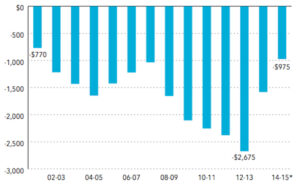After-school, summer program funding threatened

Advocates for after-school programs will be holding a national summit in Los Angeles on Tuesday to build opposition to a plan to eliminate $1.15 billion in federal funding for after-school and summer programs.
U.S. Sen. Lamar Alexander, R-Tennessee, has proposed ending 21st Century Community Learning Centers grants to states. He is the chair of the U.S. Senate Committee on Health, Education, Labor & Pensions. The committee is revising the Elementary and Secondary Education Act (ESEA), often referred to as No Child Left Behind, which includes the community learning center funding.
The committee’s revision is expected to be presented to the Senate on April 13, said Jodi Grant, executive director of the Afterschool Alliance, an advocacy group based in Washington, D.C., which is taking part in the summit.
A similar proposal to eliminate the funding by the House of Representatives was pulled at the end of last month, Grant said.
Unlike most states, California also has a well-funded state program, the After School Education and Safety Program, which provides $550 million each year. But that funding is limited to K-8 students in after-school programs. It cannot be used for older students or for summer programs.
California schools still rely on the federal dollars – more than $127 million in 2014-15 – to provide before- and after-school and summer programs.
Across the country, about 1.6 million students participate in programs funded by the community center grants each year, according to the Afterschool Alliance. In a recent report, the alliance found that 19.4 million children nationwide would participate in these programs if funding were available. The estimate is based on a survey of parents across the country in spring 2014.
California’s statewide after-school program survived budget cuts during the recession because a voter initiative created the program and allocated $550 million in a separate funding stream from K-12 education. It is just as important that federal after-school funding remain After-school, summer program funding threatened | EdSource:
Proposition 30 closes spending gap between state and nation

SOURCE: CALIFORINA BUDGET AND POLICY CENTER
This chart shows the per pupil spending gap between California's K-12 schools and the national average over the past 14 years in inflation-adjusted dollars. It has narrowed substantially in the past two years, through revenue from Proposition 30, but is still nearly $1,000 per student below average – about what it was in 2007-08, before the recession.
Revenue from temporary taxes from Proposition 30 has closed the K-12 spending gap between California and the national average by more than 60 percent, according to data released Monday by the California Budget and Policy Center, a nonprofit research organization.
The center is using data released last week by the National Education Association, and includes estimates for 2014-15, based on twice yearly surveys of the states. In 2014-15, California is expected to spend $11,190 per student, including federal, state and local revenue sources, according to the NEA, ranking the state 29th among the 50 states and Washington, D.C. California was 42nd in spending in 2012-13, with spending of $9,013 per student.
The reason for the increase is Proposition 30, a seven-year tax increase that California voters passed in 2012. It is expected to bring in an additional $7.9 billion this year in school funding through increases in the personal income taxes of the top wage earners and a higher sales tax rate.
In 2012-13, per-student spending in California was $2,675 less than the average of the 49 other states and Washington, D.C. This year, California will spend $975 less per student, according to the center.
While subject to revision, “this is the best snapshot we have,” said Jonathan Kaplan, senior policy analyst for the center.
Earlier this year, Education Week’s annual ranking placed California 46th in per-student spending, compared with 50th the previous year. But Ed Week’s rankings are three years old, based on data collected by the National Center for Education Statistics, and also were adjusted, using
